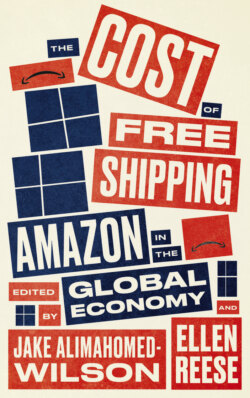Читать книгу The Cost of Free Shipping - Группа авторов - Страница 20
На сайте Литреса книга снята с продажи.
THE LOGISTICS REVOLUTION, COMPETITION, AND TIME
ОглавлениеAs global trade took off in the 1980s, the infrastructure needed to move the growing volume of goods expanded and the logistics revolution transformed the way goods were moved.9 According to World Bank figures, the number of twenty-foot equivalent units (TEUs) (measured as shipping containers) entering the world’s ports grew from 224.8 million in 2000 to 752.7 million in 2017, while freight carried by airlines around the world increased from 118.3 million ton-kilometers to 213.6 million over that period. The World Bank figures for rail movement are incomplete, but these rose from 2.3 million ton-kilometers in 2000 to 5.8 million in 2007.10 And this was before the shift of the center of world economic activity eastward and the escalating density of rail traffic in Asia and China’s 10,000-mile-long Silk Road freight railway from China to Europe, all part of China’s “One Belt, One Road” development initiative.11
In the U.S., the dollar value of all freight doubled from 1998 to 2017, while the newest form of rapid movement, intermodal truck/rail freight rose by 6½ times, from a value of $70 billion in 2002 to $460 billion in 2017.12 The number of warehouses grew by nearly 2¾ times, from 1998 to mid-2019 to over 18,000, while their size increased dramatically and the warehouse workforce nearly doubled to just over a million production and nonsupervisory workers.13 As logistics guru Yossi Sheffi put it, “Physical infrastructure dominates logistics investment.”14 This infrastructure has become, as LeCavalier put it, “the connective tissues and the circulatory systems of modernity.”15 Or at least, of modern capitalism.
While there are countless Third Party Logistics (3PL) firms globally and in the U.S. that help move things around this circulatory system, there are a few that dominate the industry in the U.S. and to some extent internationally, such as UPS, FedEx, XPO, DHL, Ryder, J.B. Hunt, and Schneider. UPS operates 1,000 package handling facilities, while FedEx has 1,200.16 FedEx and UPS also command large fleets of aircraft and huge airport facilities. Most of these were formerly trucking or package delivery firms that transformed themselves into massive full-service logistics operations in the early twenty-first century. All of these appear in both Transport Topics’ “Top 100 For-Hire-Carriers” ranking of trucking firms and its “Top 50 Logistics” companies for the U.S.17
Sheffi also reminds us that “an information supply chain parallels each physical supply chain.”18 In addition to the expansion of transportation infrastructure, new technology in the form of bar codes, Radio Frequency Identification (RFID), Electronic Data Interchange (EDI), GPS, “data Warehouses,” “big data,” and the “cloud” enabled new levels of prediction, tracking, coordination, movement, and work intensification.19 Information technology links all aspects of logistics from the movement of goods over roads, rail, air, and sea, to the various distribution and fulfillment facilities and their internal functioning. Huge data warehouses or centers are a key part of this physical supply chain infrastructure and central to the effort to speed up and smooth out the movement of goods and money. By 2019, there were about 2,500 data centers in the U.S.—a part of logistical infrastructure that barely existed twenty years earlier.20
In retail, it was first and foremost Walmart that pulled together all these strands in contemporary logistics, including the massing of data about the behavior of consumers and the movement of goods from producer to distribution center to big box store. It was Walmart that pioneered the cross-dock warehouse in which goods move in one door and out another without being racked or stored.21 Yet, a difference in the centrality of logistics between Walmart and Amazon can be seen in the fact that as of 2019 Walmart had only 114 distribution centers in the U.S., while Amazon had some 477.22 Thus, it would be Amazon that applied the lessons of logistics infrastructure and technology to the movement of other people’s goods to its own customers, without the costly stores.
The growth of global logistics has intensified both competition and the speed at which things are produced and moved to market. Beginning with the introduction of lean production and just-in-time (JIT) inventory into the West from Japan in the 1980s, the speed at which goods moved through production and along supply chains accelerated. By the twenty-first century, time itself became a leading factor in competition as “lead-time”—that is, the time from production to the market—was shortened as much as possible in order to gain advantage over rivals. Hence “Time-Based Competition” increased demands on the methods, technology, infrastructure, and workforce of logistics.23
By building its logistics and digital capacity and infrastructure, Amazon would become the master of what Marx called, “the annihilation of space by time.”24 By the time Amazon had moved beyond just books and its first few warehouses to see its sales soar from $6.9 billion in 2004 to $232.9 billion in 2018,25 much of the groundwork for a new type of retail, tech, and logistics operation had been laid. In the process, while until recently bypassing brick-and-mortar stores, Amazon has become a deeply embedded capital-intensive company whose gross global property and equipment almost reached the $100 billion ($95.8 billion) mark by 2018.26
